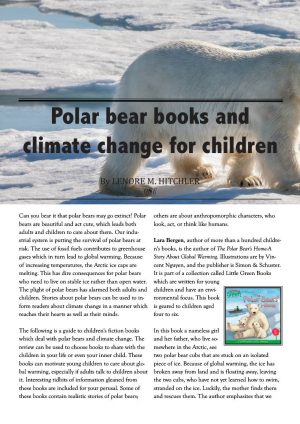 Can you bear it that polar bears may go extinct? Polar bears are beautiful and act cute, which leads both adults and children to care about them. Our industrial system is putting the survival of polar bears at risk. The use of fossil fuels contributes to greenhouse gases which in turn lead to global warming. Because of increasing temperatures, the Arctic ice caps are melting. This has dire consequences for polar bears who need to live on stable ice rather than open water. The plight of polar bears has alarmed both adults and children. Stories about polar bears can be used to inform readers about climate change in a manner which reaches their hearts as well as their minds.
Can you bear it that polar bears may go extinct? Polar bears are beautiful and act cute, which leads both adults and children to care about them. Our industrial system is putting the survival of polar bears at risk. The use of fossil fuels contributes to greenhouse gases which in turn lead to global warming. Because of increasing temperatures, the Arctic ice caps are melting. This has dire consequences for polar bears who need to live on stable ice rather than open water. The plight of polar bears has alarmed both adults and children. Stories about polar bears can be used to inform readers about climate change in a manner which reaches their hearts as well as their minds.
The following is a guide to children’s fiction books which deal with polar bears and climate change. The review can be used to choose books to share with the children in your life or even your inner child. These books can motivate young children to care about global warming, especially if adults talk to children about it. Interesting tidbits of information gleaned from these books are included for your perusal. Some of these books contain realistic stories of polar bears; others are about anthropomorphic characters, who look, act, or think like humans.
Lara Bergen, author of more than a hundred children’s books, is the author of The Polar Bear’s Home-A Story About Global Warming. Illustrations are by Vincent Nguyen, and the publisher is Simon & Schuster. It is part of a collection called Little Green Books which are written for young children and have an environmental focus. This book is geared to children aged four to six. In this book a nameless girl and her father, who live somewhere in the Arctic, see two polar bear cubs that are stuck on an isolated piece of ice. Because of global warming, the ice has broken away from land and is floating away, leaving the two cubs, who have not yet learned how to swim, stranded on the ice. Luckily, the mother finds them and rescues them. The author emphasizes that we must prevent further climate change to adequately protect the entire species. During the course of the story, children learn that polar bear cubs only weigh a pound when born. Adults have a four-inch layer of fat to keep them warm, which means that even in winter they can get overheated. The final page includes suggestions of things that children can do to help the bears, including recycling, turning off lights and televisions, and unplugging computers when not in use.
Carol Carrick is the author of The Polar Bears Are Hungry and nearly fifty other books for children and young adults. Her son, Paul Carrick, is the illustrator, and Clarion Books is the publisher. This story is about a mother polar bear and her two cubs. According to the book, polar bears do not swim fast enough to catch seals in open water. Therefore, they need to capture the seals at the air holes that the seals use during the colder months. The sea ice has melted during the summer leaving the bears hungry because they can no longer capture seals on the ice. The mother needs to produce milk for her cubs, so she brings them into an Arctic village to find some food. She and her cubs are caught and put into a cage, and eventually they are set free. During the time the bears are in cages they are given water, but no food. This is meant to discourage them from returning to scavenge in human settlements.
Jean Craighead George, is a well-known and beloved children’s author with a degree in both science and literature. She is the author of over one hundred children’s books on animals and nature, and is the author of The Last Polar Bear. Wendell Miner is the illustrator of the book, and HarperCollins is the publisher. This book is geared to children aged four to eight. The main characters, Tigluk and his grandmother, devise a plan to save the last polar bear cub. Because of rapid melting of the ice, the little cub is orphaned and in trouble. It is not clear whether this is the last polar bear on the planet or just that particular region of the Arctic. Unfortunately, the solution to the cub’s problems is unrealistic as Tigluk plans to teach the cub to survive in a warming world, which seems more like a fantasy than a doable solution. It also ignores the fact that if there is only one polar bear left, the species could not survive. Nevertheless, the book tells a touching story. This book shows a child acting in an empathetic and compassionate manner towards a fellow creature.
Sandra Markle, a former elementary school teacher who has published over two hundred nonfiction books for children, is the author of Waiting for Ice. Alan Marks is the illustrator, and Charlesbridge is the publisher. The book is geared to children aged four to eight. Like Craighead George’s The Last Polar Bear, Waiting for Ice is about an orphan polar bear. However, it doesn’t contain humans, magical solutions or anthropomorphic characters. The book is realistic and shows both the struggles of an orphaned female ten-month-old polar bear cub and the impediments to the survival of the species as they respond to global warming. The polar bears in Markle’s story live on Wrangel Island, north of Russia. When not hunting for prey in the sea, polar bears need to rest on ice floes. During the summer the ice packs melt and then refreeze when it turns colder. Traditionally this occurred in September. However, due to global warming, the ice pack is more prone to developing in late November. The polar bears are thus forced to remain on the island because of the lack of adequate, stable ice. While the bears are stuck on the island, the main food supply consists of migrating birds and walruses. However, there is not enough prey to provide all of the bears with the high-fat diet which they must consume. The bear cub’s fortitude in staying alive is endearing. The reader feels empathetic to the female polar bear cub in particular, and the rest of the bears in general. The back of the book includes some interesting facts about polar bears such as the fact that their coats look white, but are not. Sunlight passes through the coat hairs to its black skin, which soaks up this solar energy. The final page provides sources to additional information including Polar Bears International and such interesting tidbits as the fact that polar bears have been called “old man in the fur cloak” and “white sea deer” by various societies.
Jean Davies Okimoto is the author of Winston of Churchill: One Bear’s Battle Against Global Warming. Okimoto has written books for both children and adults. The book is illustrated by Jeremiah Trammell and Sasquatch Books is the publisher. The book is geared to children six to eight. The book is very anthropomorphic. The main character is a polar bear called Winston Churchill who is the leader of a bear protest in Churchill, Manitoba, Canada. He smokes a cigar and talks like the historical Winston Churchill. Winston has written a book called Why It’s Getting Hotter, which provides an excellent scientific explanation to children about global warming. It explains greenhouse gases, how they cause the greenhouse effect, and how we can limit them. Winston also organizes a protest by the bears, who carry signs saying “Freeze Please,” “Save our Home,” “Brrrr is Best,” “Cool It,” and “Ice is Nice.” Some other signs are “Turn Stuff Off,” “Solar Power,” “Turn Down the Furnace,” “Make Less Garbage …Recycle,” and “Save Trees.” The demonstrating bears are endearing to readers and present protest demonstrations as a valid and reasonable form of action. The last page includes scientific information on the conditions of polar bears. For example, ice in Hudson Bay is breaking up earlier in the year. Because there is less ice in the ocean, polar bears must swim greater distances and sometimes even drown. The bears have lost weight because they are unable to consume enough food. Also, fewer bear cubs are born, and many do not survive. Thus, there are fewer polar bears, and the ones who do survive are not healthy, which contributes to even more polar bear deaths.
Each of these books shows children why global warming should be stopped and ways in which it can be done. The books have lovely illustrations. They also teach children some of the bare facts about polar bears.
Lenore Hitchler

